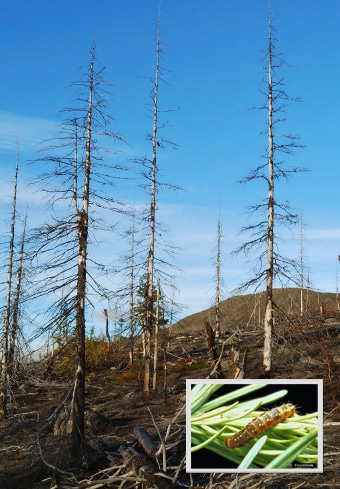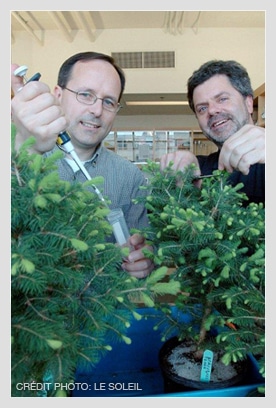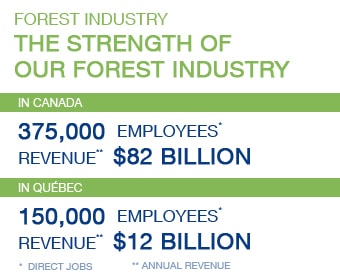Scientist and university professor John MacKay has discovered that spruce have a gene naturally resistant to the budworm, the most destructive insect affecting our forests.
Since Arborea I and II, scientist and university professor John MacKay has been busy sequencing the spruce genome, and his research is paying off! With his team, he has discovered that spruce have a gene naturally resistant to the budworm, the most destructive insect affecting our forests.
Genomics could have answers to forest industry renewal!
The forest industry is undergoing massive transformation. Timber resources – the raw material of forests – are dwindling, and replenishing them requires time and patience. In a highly competitive worldmarket, every minute counts. That’s why forest genomics expert John MacKay of Université Laval, and his team, began searching for innovative ways to ensure the sustainable development of our forests.
THE SPRUCE BUDWORM,
SMALL BUT DEVASTATING
Every 30 years or so, the spruce budworm attacks the boreal forest. Despite its tiny size (no longer than 20 to 33 mm), this caterpillar has a huge appetite. In just a few years, it can devastate millions of hectares of trees. Its preferred victim is the balsam fir, more specifically its buds. Stunted in their growth, the trees die after only 5 years. The last budworm outbreak (1968-1990) killed approximately 180 million cubic meters of trees and roughly the same through reduced rate of growth.


Forest genomics supporting sustainable development
During the 2000s, John MacKay and his colleague Jean Bousquet, both based in Québec City, launched Arborea I and II, with the support of Génome Québec. Their goal was to find efficient, sustainable solutions to the problems facing the forest industry. They found answers through genomics.
Genomics is being used to pinpoint the strengths and weaknesses of each species under study. This, in turn, helps to single out the best trees for reforestation and identify the varieties most likely to adapt to new climatic conditions. The data collected make it possible to select the highest performing tree seedlings based on their genes.
Forest genomics sowing the seeds of hope
With the help of genomics, researchers are also discovering never-before-seen characteristics. For instance, by sequencing the genome of spruce – a tree especially valued for its toughness – researchers have made an especially encouraging discovery. They have found that spruce possess a gene that make them naturally resistant to budworm, the most devastating insect to coniferous stands in North America. This knowledge raises hope for new ways of fighting this parasite that destroys hundreds of thousands of hectares of trees every year. This important discovery is only one of the preliminary findings to result from the sequenced spruce genome. The study, which was launched in 2011, is being conducted by the SMarTForests team under the leadership of John MacKay and Joerg Bohlmann of the University of British Columbia.
PERFORMANCE-DRIVEN
RESEARCH
Researchers believe that forest genomics has tremendous potential. It can:
- facilitate intensive, high-yield reforestation in the short term (3 to 5 years);
- increase forest regeneration in the medium term (5 to 10 years);
- supply the industry with top-performing raw materials (wood quality and quantity) in the long term (10 to 20 years).

